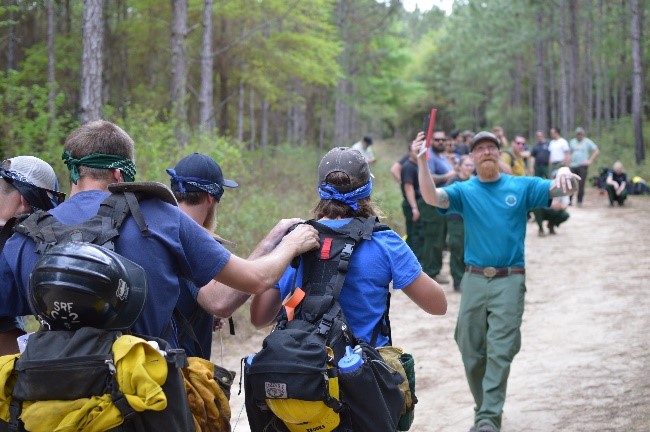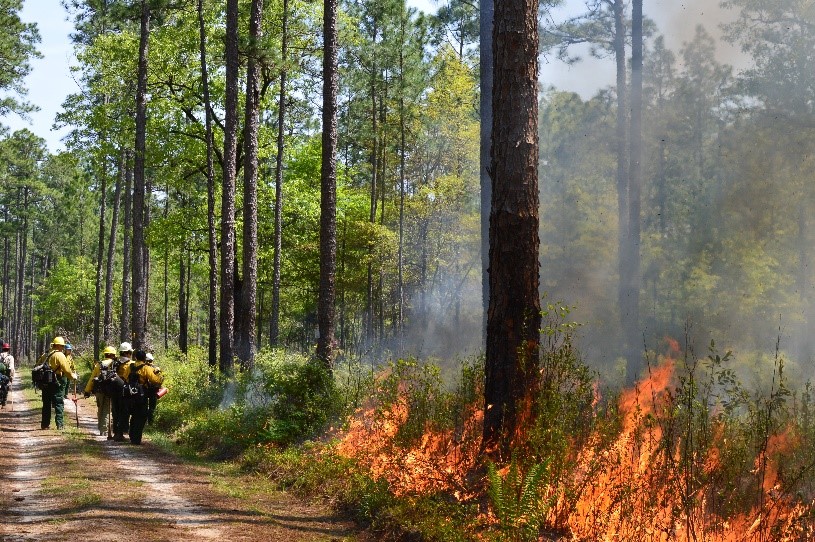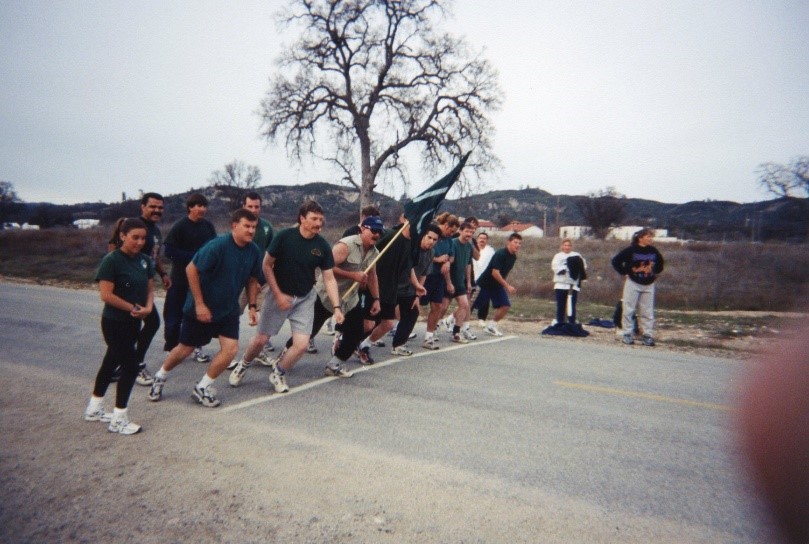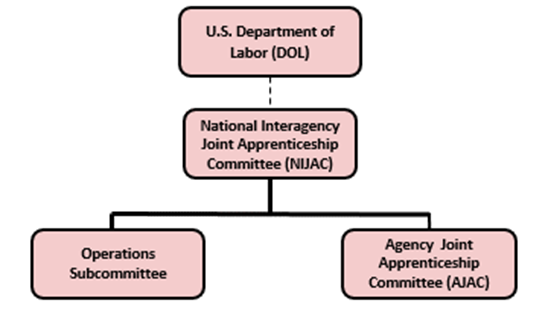The Wildland Firefighter Apprenticeship Program is registered as a part of the National Apprenticeship Program in accordance with the Department of Labor, designed to enhance and develop future Fire and Aviation Managers. The intent of the Program is to take a career entry firefighter and provide education, training and paid work experience over a 12 to 48 month period, depending on experience. Upon successful completion of all the requirements of the Apprenticeship Program, the apprentice will reach journey-level status as a wildland firefighter.
Program Summary
 The Wildland Firefighter Apprenticeship Program is registered as a part of the National Apprenticeship Program in accordance with the Department of Labor, designed to enhance and develop future Fire and Aviation Managers. The intent of the Program is to take career entry firefighters and provide a hybrid of education, training and paid work experience of 3,000 hours. Apprentices will either attend a Basic academy (optional if prerequisites met) and/or a Advanced academy (mandatory). Successful completion of the program requires 2 of the 4 options: Engines, Handcrews, Aviation, Dozers (one of which must be either engines or handcrews). In addition, mandatory training of S-211, S-212, S-260, ICS-200, New Employee Orientation, and 120 hours of electives. Apprentices will obtain "journey-level” status as Wildland Firefighter Specialists and be fully-qualified Firefighter Type 1s (FFT1).
The Wildland Firefighter Apprenticeship Program is registered as a part of the National Apprenticeship Program in accordance with the Department of Labor, designed to enhance and develop future Fire and Aviation Managers. The intent of the Program is to take career entry firefighters and provide a hybrid of education, training and paid work experience of 3,000 hours. Apprentices will either attend a Basic academy (optional if prerequisites met) and/or a Advanced academy (mandatory). Successful completion of the program requires 2 of the 4 options: Engines, Handcrews, Aviation, Dozers (one of which must be either engines or handcrews). In addition, mandatory training of S-211, S-212, S-260, ICS-200, New Employee Orientation, and 120 hours of electives. Apprentices will obtain "journey-level” status as Wildland Firefighter Specialists and be fully-qualified Firefighter Type 1s (FFT1).
 The WFAP delivers innovative and fundamental training for the development of wildland firefighters. The curriculum offered changes annually based upon apprentice needs analysis and agency workforce needs. We offer many NWCG courses along with other great courses to develop future fire leaders. This program allows apprentices to network with fellow apprentices, cadres and staff from all over the nation. In addition, to the NWCG curriculum we offer courses in career development, human performance optimization, business, risk and safety as well as the opportunity to attend a staff ride.
The WFAP delivers innovative and fundamental training for the development of wildland firefighters. The curriculum offered changes annually based upon apprentice needs analysis and agency workforce needs. We offer many NWCG courses along with other great courses to develop future fire leaders. This program allows apprentices to network with fellow apprentices, cadres and staff from all over the nation. In addition, to the NWCG curriculum we offer courses in career development, human performance optimization, business, risk and safety as well as the opportunity to attend a staff ride.
Our academies are for wildland firefighter apprentices who are currently employed with one of the Federal land management agencies (USFS, BLM, FWS, NPS, BIA). Attendees are sent to us from their respective sponsoring units/agencies. The academies are not open to the public.
If you’re interested in becoming an apprentice job announcements are typically available mid-summer on usajobs.gov. Apprentice positions are permanent career conditional employees with positions available throughout the nation. This is a great program if you’re interested in making wildland firefighting a career!
History of The Wildand Firefighter Apprenticeship Program
 The Wildland Firefighter Apprentice Program (WFAP) was originally developed by a group called National Joint Apprentice Committee (NAT JAC). NAT JAC was a collaborative between a contracted vendor (Richard Wharton) and staff from the U.S. Forest Service (FS) and the Bureau of Land Management (BLM). Wharton had hired a recently retired Forest Service employee, Denny Bungarz to serve as the first manager for the program. In 1990 the first academy session was held at the Radisson Hotel in Sacramento. The focus of the program was largely intended to be in response to the 1979 consent decree in an attempt to bring more diversity into the firefighting workforce at the entry level. In its time (early 1990’s) the program was one of the few ways for a temporary employee to become a permanent employee. The agencies began to look at the program as a way to identify and develop future fire management officers. In 1990, the program was administered under a set of standards developed with the Department of Labor (DOL) and became the first of its kind, recognizing graduates of the program as journey level working wildland firefighter specialists with the DOL. While the academy venues changed (various hotels in Sacramento), the program remained relatively consistent between 1990 and 1996. Academies had roughly 80 students, about 70% were FS Region 5 employees, about 15% were other FS regions and 15% were Bureau of Land Management (BLM) from a variety of states. In 1997, the Federal agencies ended the contract with NAT JAC and the program was administered by the FS Region 5. This academy (Academy #8) was held at the Boy Scout Camp in San Luis Obispo. Due to costs associated, a new location for the program was selected (Fort Hunter Liggett) and Region 5 hired an Apprentice Program Manager, Shirley Sutliff to manage the program on a fulltime basis. Under Sutliff’s leadership, the National Interagency Joint Apprentice Committee (NIJAC) was formalized and associated Agency Joint Apprentice Committees (AJACs) were stood up. Partnering agencies included the addition of the U.S. Fish and Wildlife Service (USFWS), the National Parks Service (NPS), and the Department of Interior (DOI). The first revision to the apprenticeship program standards occurred in 2002. This version was signed by the Secretaries of Interior and Agriculture with the intent that “the Wildland Firefighter Specialist program will provide trained firefighters and future managers critical to fire suppression and fire use to potentially replace the aging Federal firefighting workforce.”
The Wildland Firefighter Apprentice Program (WFAP) was originally developed by a group called National Joint Apprentice Committee (NAT JAC). NAT JAC was a collaborative between a contracted vendor (Richard Wharton) and staff from the U.S. Forest Service (FS) and the Bureau of Land Management (BLM). Wharton had hired a recently retired Forest Service employee, Denny Bungarz to serve as the first manager for the program. In 1990 the first academy session was held at the Radisson Hotel in Sacramento. The focus of the program was largely intended to be in response to the 1979 consent decree in an attempt to bring more diversity into the firefighting workforce at the entry level. In its time (early 1990’s) the program was one of the few ways for a temporary employee to become a permanent employee. The agencies began to look at the program as a way to identify and develop future fire management officers. In 1990, the program was administered under a set of standards developed with the Department of Labor (DOL) and became the first of its kind, recognizing graduates of the program as journey level working wildland firefighter specialists with the DOL. While the academy venues changed (various hotels in Sacramento), the program remained relatively consistent between 1990 and 1996. Academies had roughly 80 students, about 70% were FS Region 5 employees, about 15% were other FS regions and 15% were Bureau of Land Management (BLM) from a variety of states. In 1997, the Federal agencies ended the contract with NAT JAC and the program was administered by the FS Region 5. This academy (Academy #8) was held at the Boy Scout Camp in San Luis Obispo. Due to costs associated, a new location for the program was selected (Fort Hunter Liggett) and Region 5 hired an Apprentice Program Manager, Shirley Sutliff to manage the program on a fulltime basis. Under Sutliff’s leadership, the National Interagency Joint Apprentice Committee (NIJAC) was formalized and associated Agency Joint Apprentice Committees (AJACs) were stood up. Partnering agencies included the addition of the U.S. Fish and Wildlife Service (USFWS), the National Parks Service (NPS), and the Department of Interior (DOI). The first revision to the apprenticeship program standards occurred in 2002. This version was signed by the Secretaries of Interior and Agriculture with the intent that “the Wildland Firefighter Specialist program will provide trained firefighters and future managers critical to fire suppression and fire use to potentially replace the aging Federal firefighting workforce.”
The academy venue changed again in the early 2000’s with a move to the current location in McClellan at the R5 North Operation’s Wildland Fire Training Center (WFTC). After the implementation of the National Fire Plan (NFP) in 2001, the program grew considerably from 150 new apprentices to over 500, requiring multiple academies per year. A large volume of apprentices from both the FS and DOI Bureaus participated in the program during that time. In 2009, the program became a national FS program administered through the National Fire Training Center (NFTC). A third revision to the standards occurred in 2010 which modified work process requirements and made minor curriculum changes. This was accomplished to expedite the time to conversion for experienced employees.
 In an effort to enhance components of the academy curriculum and minimize time in program for more experienced students, NIJAC produced a fourth version of the standards which was released in 2016. This version supports the 2012 intent from FS Chief Tom Tidwell that states, “I have approved enhancements to the program to better meet the demands for a professional and diverse wildland fire workforce. This will be the training program for new firefighter hires in every region.”
In an effort to enhance components of the academy curriculum and minimize time in program for more experienced students, NIJAC produced a fourth version of the standards which was released in 2016. This version supports the 2012 intent from FS Chief Tom Tidwell that states, “I have approved enhancements to the program to better meet the demands for a professional and diverse wildland fire workforce. This will be the training program for new firefighter hires in every region.”
The new 2016 National Apprenticeship Standards were implemented in 2017, which has allowed the curriculum taught to be tailored annually to meet the apprentice and workforce needs. The annual curriculum is determined by the Operations Subcommittee, which was stood up in 2016, based upon apprentice needs analysis and the needs of agency workforce.
Most recently, the academy was held for the first time outside of California at Solon Dixon Education Forestry Center in Andalusia, AL. Foundational Academies 4 and 5 were held here starting February 4, 2018 and finished April 13, 2018. This successful satellite delivery in the Southeast provided apprentices exposure to the southern region as well to a truly experiential learning opportunity.

Foundational Academy 4 at Solon Dixon Education Forestry Center.
Check out these videos and Get Inspired! ![]()
![]()
Hiring Wildland Firefighter Apprentices
The application period for Forest Service apprentice positions has begun. The Department of Interior agencies may be hiring apprentices in the future. Make sure to check out usajobs.gov for all federal wildland fire job announcements as well as the Forest Service hiring page for up to date information.
WFAP Governing Committees
The Wildland Firefighter Apprenticeship Program (WFAP) is governed by the National Interagency Joint Apprenticeship Committee, its subcommittees, and the Department of Labor.

WFAP Governing Committees
U.S. DOL: Oversees the Apprenticeship Program, certifies the Standards, and issues Certificates of Completion.
NIJAC: The Interagency committee composed of participating agency management employees and representatives of National Federation of Federal Employees (NFFE), which provides direction and oversight to the WFAP.
AJAC: An agency-specific committee comprised of representatives from management and labor (union), which serves as a liaison to NIJAC. Responsibilities include disseminating information/direction from the NIJAC through agency channels, and facilitating resolutions of agency-specific issues related to the WFAP.
Operations Subcommittee: This subcommittee is delegated responsibility by NIJAC for analyzing workforce needs, evaluating academy curriculum, and preparing annual updates to the Management Guide.
WFAP Program Staff
- Matt Ziegler, Program Manager
- Emily Webb, Training Coordinator
- Ryan Erne, Operations Training Specialist
- Mitch Bohn, Training Specialist
- Sheila Valentine, Administrative Operations Specialist
- Bridget Moore, Program Support Specialist